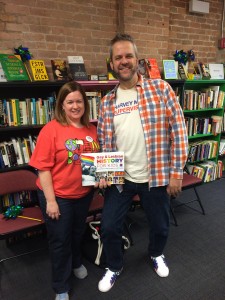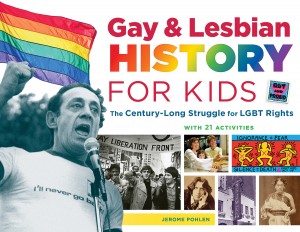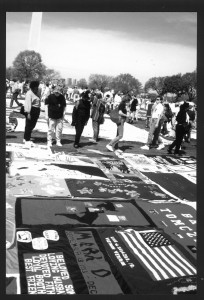
Jerome Pohlen with Open Books volunteer Jennifer Brogan after the October 17 LGBT History Celebration presentation.
Jerome Pohlen is not only a Chicago Review Press acquisitions editor but a treasured author of ours as well. We’re all very excited about his latest book: Gay & Lesbian History for Kids: The Century-Long Struggle for LGBT Rights, with 21 Activities, which published October 1 to coincide with LGBT History Month. This past Saturday, we partnered with Windy City Times and local bookseller Open Books for an LGBT History Celebration, which featured Jerome presenting the personal stories, photos, and firsthand accounts included in the book. It’s an eye-opening look for all young readers (adults too!), and a long overdue addition to the history shelves.
What was your motivation for writing an LGBT history book for young readers? Why now?
As a former elementary school teacher, I can’t imagine not teaching LGBT history in today’s world. Children don’t live in a bubble—LGBT stories are on the news, LGBT characters appear on many (if not a majority of) television shows, and children have LGBT family members, neighbors, and friends. This resource will help all kids better understand the world they live in, and isn’t that the goal of education?
Teaching gay history in schools is controversial. As a former teacher, how do you see this book being used in the classroom? Do you anticipate there will be any negative reaction?
The struggle for LGBT civil rights is full of great lessons about what it means to be an American citizen—how you change unjust laws and public policy through protests, legal challenges, and simple visibility. It can be incorporated into lesson plans the same way America’s civil rights movement has been. I am neither African American nor a woman, yet I have personally learned from Rosa Parks’s story and the Montgomery bus boycott. The same holds true for readers of my book. They can all learn about courage, honesty, empathy, and individuality, whether or not they are LGBT.
 Why do you think it’s important for LGBT history to be taught in schools?
Why do you think it’s important for LGBT history to be taught in schools?
History is history and it shouldn’t be erased, as it has in the past, when it has an LGBT element. A gay man, Alan Turing, led the team that cracked the German Enigma code and likely shortened World War II by two years. Children learning about the war should know this. Some people may ask whether his sexual orientation matters in telling this story. Of course it does. It mattered to the police who later persecuted Turing for being gay, it mattered to government officials who destroyed his career as a “security risk,” and it mattered to Turing, who took his own life as a result. Fortunately, today’s stories have much happier endings, which children need to hear as well.
A a self-proclaimed history buff, did you learn anything you didn’t previously know while doing research for the book?
So much! I did consider myself fairly informed before I began this project, but I had no idea of the holes in my knowledge. Until very recently, few LGBT histories touched on the work of Germany’s Dr. Magnus Hirschfeld and the Scientific-Humanitarian Committee, the world’s first gay rights organization. And yet, part of the story was right in front of me all along: the infamous Nazi book burnings started with Hirschfeld’s extensive library. Many of the photos you see in books and online today are of that first rally, yet seldom mentioned the gay connection—I certainly never recall hearing about it, even though the photos clearly show a bust of Hirschfeld being tossed on the bonfire
The book explores major events and accomplishments related to LGBT figures throughout history. Do you have a favorite story that you included in the book?
I love the story of Frank Kameny sending the Mattachine Society of Washington’s newsletter to J. Edgar Hoover. The FBI freaked out and sent an agent to confront Kameny. “Take Hoover’s name off the mailing list,” the agent demanded. But based on what the agent said, Kameny figured out that MSW was being spied upon by the FBI. So Kameny made his own demands: “I won’t take Hoover’s name off the mailing list until you destroy all the FBI’s files on us, and Hoover sends us a letter confirming it’s been done.” His bluff called, the FBI agent left and never returned. Lesson: Stand up to bullies.
Having identified as gay early on in your life, did you not see yourself in books, TV shows, and prominent roles? How did the lack of gay role models made you feel?
For years I was completely in the dark, and I was only able to put a name to my feelings when Anita Bryant launched her anti-gay crusade in Florida. It was all over the news, and I remember thinking, So that’s what I am! And even though there were almost no LGBT characters on TV, I almost always gravitated toward LGBT actors, usually comedians—Charles Nelson Reilly, Lily Tomlin, Paul Lynde, Nancy Kulp—because I could relate to their odd senses of humor. How strange that Bryant helped me feel better about myself—I thought being demonized by such an unpleasant person was a badge of honor—and screwball comedians helped me laugh at the bullies.

Jerome Pohlen took some of the photos in the book, including this one of the NAMES quilt at the 1993 March on Washington.
Many of the photos in the book were taken by you or your husband. Which historical LGBT events did you experienced firsthand?
We’ve been involved in the movement from the early ’90s. Jim earned the ACT UP button shown in the book after being dragged off and arrested at a Chicago protest about two months before I met him. In 1993, a year after we met, we attended the March on Washington for Lesbian, Gay & Bi Equal Rights and Liberation, where I took the photos of the AIDS quilt [left] and the military honor guard that led the massive parade. And of course, we were involved in the effort to bring same-sex marriage to Illinois, through several Valentine’s Day protests at the Cook County clerk’s office and lobbying days in Springfield. And the family whose story frames the book through the introduction and conclusion are friends of ours.
Which causes are you most passionate about?
I would love to see more LGBT issues and concerns integrated into schools—children have a right to understand the world around them, and the LGBT community is a part. In recent years, educators have made great advances in bringing more stories of women and people of color into the classroom curriculum, and the same should be true of LGBT individuals’ stories. Only California currently does this by statute, and that just started this fall. And not just curriculum. Even more important, schools need to be safer spaces for LGBT youth, to allow them to thrive, particularly trans youth, who face the greatest challenges.
Let’s say in ten years, Chicago Review Press publishes an updated edition of your book, with one additional chapter at the end. What historic achievements would you hope to be able to include in this new chapter?
The previous ten years have been a golden era for LGBT rights in the United States, but there has been far less progress worldwide (outside of Europe and some Latin American countries). In ten years I would love to be writing about advances for LGBT people in Africa, Russia, and the Middle East. It sounds unrealistic, but a decade ago the possibility of marriage equality in the Unites States seemed ridiculous, yet here we are.
—compiled by Caitlin Eck
Gay & Lesbian History for Kids officially published on October 1, 2015. It is available for purchase everywhere books and e-books are sold, including our website.
No Comments
No comments yet.